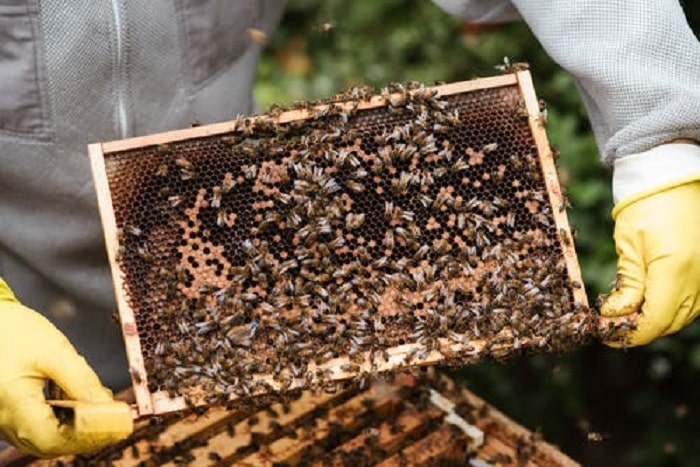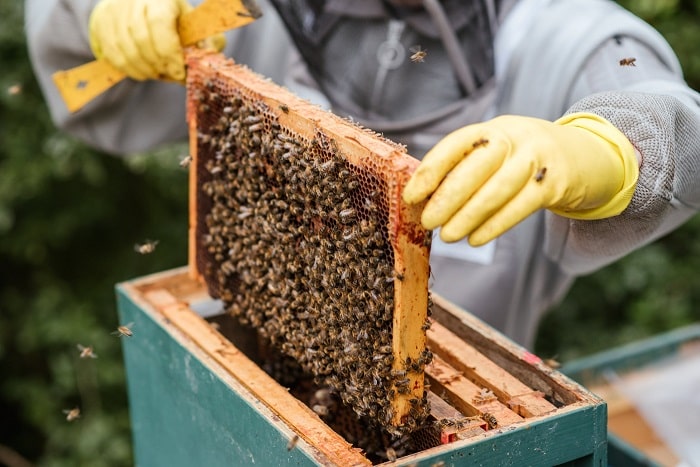Beekeeping is becoming increasingly popular as a hobby. Many budding gardeners and country folk are drawn to this activity because of the health (and taste) benefits of natural honey. So, how to start beekeeping beginners? This is our beginner’s guide to beekeeping, including what hive to buy, what equipment you’ll need, and how to get that delicious honey…
What should you know about bees?
A honeybee colony will have 30,000-50,000 bees on average, depending on size. The queen, who produces up to 1,500 eggs per day. Worker bees who administer the hive. And drones, which are male bees who mate with Queens from neighboring colonies. All live in one society.
Understanding bee biology is critical for all novices. You will learn the fundamentals, such as proper terminology, equipment use, and how to manage bees seasonally.

Which beekeeping equipment do you need?
- Woodenware
This is the beehive itself. It consists of the hive bottom, hive body, and top cover. We suggest starting with two hives/colonies so you can compare them to see what works—and what doesn’t.
- Protective veil and gloves
Stings should be avoided at all costs, especially by inexperienced beekeepers. If you do not want to get stung, get distracted, and drop a frame on the ground, this equipment is necessary.
- Smoker
This helps calm and distract the bees while you’re working within the hive.
- Hive tool
This must-have, resembling an elongated paint scraper, helps you to effortlessly access the hive and shift frames around.
How much will it cost to keep bees?
This cost varies according to where you live in the country. In your first year, you may expect to spend between $800 and $1,000 on putting up two hives. The price includes both the apparatus and the bees. Furthermore, you will need to purchase protective gear as well as hive-specific wooden utensils. To ensure a long service life, we recommend investing in high-quality items.

>>> Read more: Best Honey Extractors Review 2021 – Manual And Electric Options
How much time will you need to devote?
Like any hobby, you get out of beekeeping what you put in. Overall, we recommend allocating one hour per week to managing your bees for every two hives. However, certain seasons will be busier than others. You’re going to spend a little more time in the springtime as the bees emerge out of winter and start expanding. Not quite as much in the summer. And then a little more in the fall.
Where should you put your beehives?
You should face the opening of each hive in the south, east or southeast direction for optimal placement. This way, bees can soak up the morning sun (which helps them wake up and function) and then cool off in the afternoon shade. Avoid any backyard hotspots with lots of activity, such as sidewalks or swings. And, of course, place the hive in a convenient and easily accessible location for your beekeeping convenience.
When is the best time to start beekeeping?
The answer varies depending on climate and region. But there are 2 landmarks that you should pay attention to.
First and foremost: In the fall or winter, you should enroll in a beekeeping lesson (around November or December). Then, you will order your bees and equipment from there. When your bees arrive in the spring (usually in April), you will install your hive and spend the next 3-4 months feeding them a sugar-water mixture. That allows them to construct and draw out wax combs, which allows them to lay eggs and be more productive.
After that, once your colony has developed and is doing well enough, you can gather honey in the fall. The bees will subsequently be “put to bed” and prepared for the colder months ahead in November. You should seal them up, shield them from wind, make sure they are aired so there is no moisture issues inside the colony. Then you do not do anything in the hive in December/January/February. However, you should check them to ensure that they have enough honey stored within them.

What causes the extinction of bee colonies?
Prepare to hear the harsh reality: It is a safe chance that your bees will perish for the first time (or two). There’s a high failure rate, especially in the first two or three years. It is true that the process requires experience and perseverance, but don’t give up too soon. In reality, beekeeping errors aren’t the only prevalent cause of hive death—pests, particularly mites, may wreak havoc on your hives as well.
Beekeeping tips for beginners
-
Buy the bees
It may appear unusual to order bees before gathering all the necessary equipment for beekeeping. But it is significant since most sites do not have bees for sale by the time spring arrives. Order your bees in January for shipment or pickup in April or May.
Local beekeeping associations are an excellent location to start looking for bees. You’ll also need to decide whether packaged bees, collecting a swarm, or purchasing an already-started hive are the best option for you. Each has its own set of benefits and drawbacks.
-
Gather beekeeping supplies
Keeping bees necessitates an initial investment in materials. You will need to buy a hive once you have decided on the type, but you will also need some bee tools, protective clothes, and feeding supplies. You may also brush up on your beekeeping knowledge by reading a few basic beekeeping books.
-
Introduce bees to the hive
Now comes the exciting part! Your bees have arrived, and it’s time to get them established in the hive. You must introduce the bees to their new home in a secure and comfortable manner. Then, sit back and study the comings and goings while they settle in.
Related Posts:
